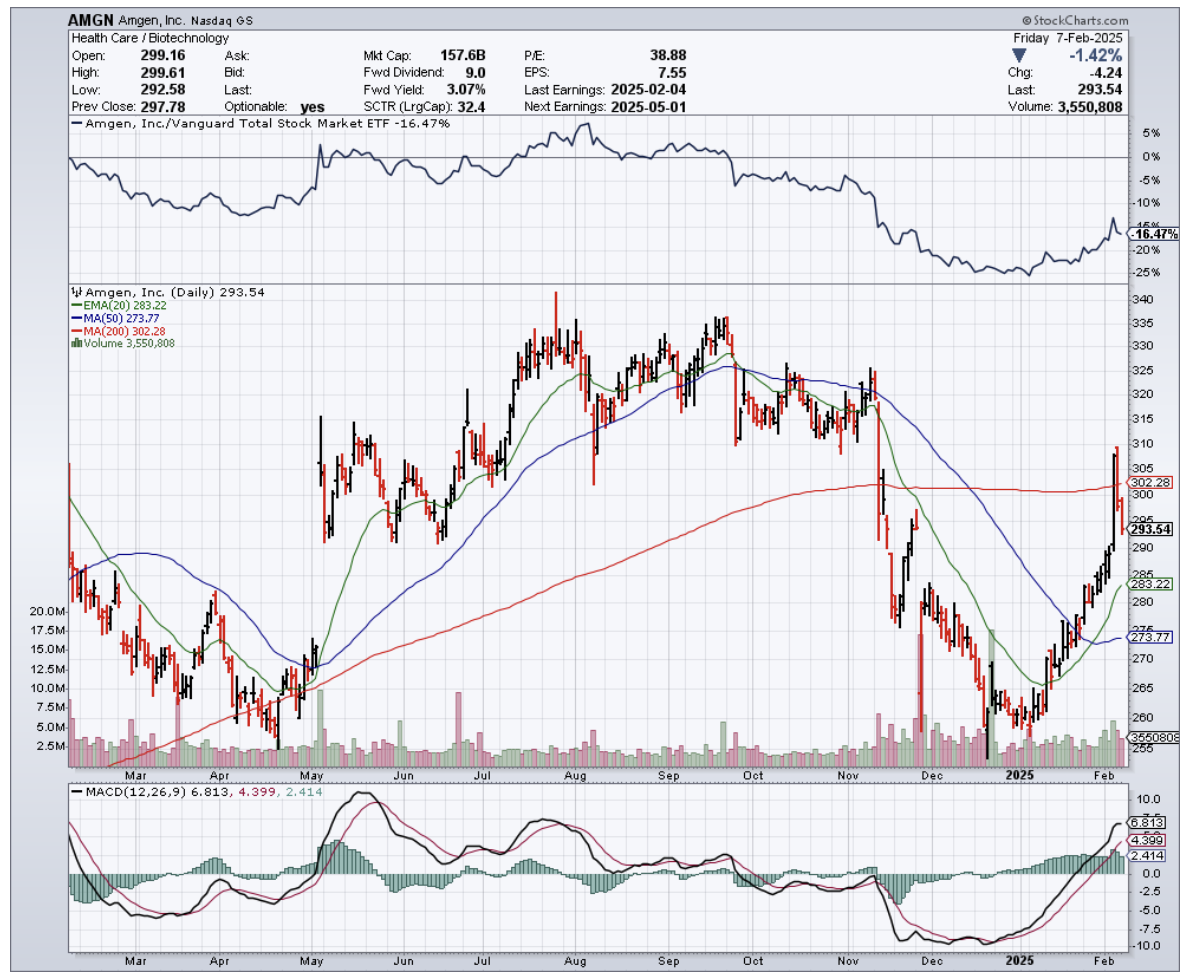Back in 1989, when I was setting up one of the first international hedge funds, I learned a timeless lesson about pharmaceutical stocks: the market doesn't care what you think it should care about—it cares about whatever it wants to care about.
That was on full display last week, as I watched Amgen (AMGN) dance its post-earnings tango and rally despite the FDA putting a mysterious hold on its obesity drug trials.
The stock’s move was exactly what its technical patterns suggested.
After managing hedge fund money for decades, I’ve seen literally millions of chart setups, and AMGN’s current formation is one of those rare “textbook” moments that make veteran traders sit up a little straighter in their ergonomic chairs.
The numbers paint a fascinating picture. Amgen isn’t just any biotech; it’s one of the dwindling few in the Dow 30 that still yield north of 3%. In this market, that’s about as rare as finding a bargain at Sotheby’s.
Better yet, it carries a dividend safety rating of A—something I’ve come to value above all else after living through multiple market crashes.
In my experience, dividend safety is the bedrock on which everything else is built, so seeing that in a company is like stumbling upon a bomb shelter with a view.
Digging deeper, the company just delivered a revenue beat that would make any analyst grin, but the real hook for me is the pattern of earnings revisions.
They’re trending up more than down, fueling a kind of momentum that reminds me of the early days of Genentech’s meteoric rise back in the 1980s.
Of course, there’s an elephant in the room: valuation.
With a D- grade in that department, Amgen’s price tag is about as stretched as my old climbing rope from Mount Everest. But modern markets aren’t your grandfather’s markets anymore.
The days of pure buy-and-hold being a guaranteed winning strategy have gone the way of paper trading tickets, replaced by algorithms and new trading paradigms.
This is why I like to employ what I call the "Triple-Lock Position" strategy.
Essentially, you buy the stock, buy a put for protection, and sell a call to offset that cost - three distinct moves that work together to lock in your risk parameters.
With Amgen hovering around $300, one round lot sets you back roughly $30,000. That price tag is a good reminder that position sizing matters more than ever.
Meanwhile, Amgen’s profitability metrics remain consistently top-tier.
From my hedge fund experience, steady cash flow and consistent profits often trump the promise of explosive growth, especially when storm clouds gather.
In volatile markets, companies that can reliably generate cash tend to outlast the flashier high-flyers.
Then there’s the technical angle. After analyzing enough charts to wallpaper the old Swiss Bank Corp building, I can say these trend lines have been as reliable as a Swiss watch.
Yes, we see the occasional short-term break, but it’s akin to a compass briefly pointing south before swinging back to true north.
For those who track this stuff closely, AMGN appears to be offering one of those rare situations where technical strength aligns with fundamental quality.
So what’s the play? I see Amgen as a “buy the dip” opportunity, but I suggest doing it with a twist. Instead of simply loading up on shares the old-fashioned way, consider collaring your position or using call options to define your risk.
Markets these days reward flexibility, and adapting your strategy to the current environment is crucial—something I learned during the Asian financial crisis, when clinging to outdated rules was a surefire path to disappointment.
All of this brings us back to that FDA hold on AMG 513. The market’s collective shrug reminds me of an old trading floor saying: “The market will decide what to worry about, not us.”
In biotech, as in most sectors, the reaction to news often reveals more than the news itself. Watching how investors brush off certain announcements can be more informative than pouring over the finer details.
Keep a close eye on those trend lines, because they’ve served as a pretty good compass so far. AMGN is showing the kind of setup where technical signals and strong fundamentals converge, and that rarely goes unnoticed for long.
Just remember, in the modern market, it’s not only about what you buy; it’s about how you buy it. The once-reliable buy-and-hold mindset is no more current than my old Financial Times columns from the 1970s.
Now, if you’ll excuse me, I need to check on my option positions. The market waits for no one—not even old hedge fund traders with stories to tell.

